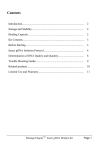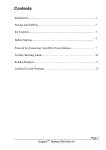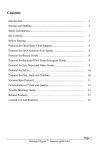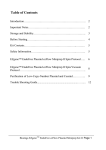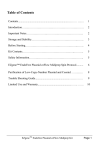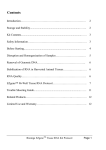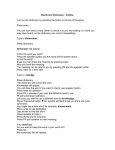Download Kit Manual
Transcript
Contents
Introduction.........................................................................................
2
Storage and Stability...........................................................................
2
Binding Capacity................................................................................
2
Kit Contents........................................................................................
3
Before Starting....................................................................................
3
EZgene™ Mollusc / Arthropod DNA Protocol..................................
4
Determination of DNA Quality and Quantity....................................
7
Trouble Shooting Guide......................................................................
8
Biomiga EZgeneTM Mollusc gDNA Miniprep Kit
Page 1
Introduction
The EZgene™ Mollusc gDNA Kit is designed to extract genomic DNA up to 60 kb
in size from molluscs, insects, arthropods, roundworms, flatworms, and other
invertebrate tissue samples rich in mucopolysaccharides. The method is suitable for
invertebrates frozen or preserved in alcohol or DNE solution, and good results can
be obtained with formalin preserved material.
Samples are homogenized and lysed in a high salt buffer and extracted with
chloroform to remove
mucopolysaccharides.
Following a rapid alcohol
precipitation step, binding conditions are adjusted and DNA further purified using
ezBind DNA spin columns. While proteins and other contaminants are removed by
wash buffer, high quality genomic DNA is eluted with elution buffer or sterile
water. The purified genomic DNA is suitable for downstream applications such as
Southern Blot, restriction digestion, and PCR.
Storage and Stability
All components of the EZgene™ Mollusc gDNA Kit, except the Proteinase K and
RNase A should be stored at 22oC -25oC. Once reconstituted in water, Proteinase K
should be stored -20oC.Under these conditions, DNA has successfully been purified
and used for PCR after 24 months of storage. During shipment, or storage in cool
ambient conditions, precipitates may form in some buffers. It is possible to dissolve
such deposits by incubation the solution at 65 oC. Store RNase A at -20 oC. All
EZgene™ Mollusc gDNA Kit components are guaranteed for at least 12 months
from the date of purchase when stored at 22 oC -25 oC.
Binding Capacity
Each ezBind DNA column can bind approximately 100 μg DNA. Use less than 30
mg of sample per column.
Page 2
Biomiga EZgeneTM Mollusc gDNA Miniprep Kit
Kit content
Product
GD2414-00
GD2414-01
GD2414-02
ezBind DNA Columns
4
50
250
2 mL collecting tubes
8
100
500
Buffer MTL
2 mL
20 mL
100 mL
Buffer MBL
2 mL
20 mL
100 mL
2.8 mL
28 mL
135 mL
Proteinase K
3 mg
30 mg
5 x 30 mg
RNase A(20 mg/mL)
55 μL
270 μL
1350 μL
DNA Wash Buffer
2 mL
15 mL
3 x 24 mL
Elution Buffer
1 mL
15 mL
70 mL
User Manual
1
1
1
Buffer KB
Before Starting
Please read the entire booklet to become familiar with the EZgene protocol.
Dilute DNA Wash Buffer with 100% ethanol as follows:
GD2414-00
Add 8 mL absolute (96%-100%) ethanol.
GD2414-01
Add 60 mL (96%-100%) ethanol to each bottle.
GD2414-02
Add 96 mL (96%-100%) ethanol to each bottle.
Reconstitute Proteinase K stock solution. Vortex vial briefly prior to use. We
recommend that you aliquot and store vials of reconstituted protease at -20 ℃.
GD2414-00
Add 110 μL Elution Buffer to the vial
GD2414-01
Add 1.3 mL Elution Buffer to the vial
GD2414-02
Add 5 x 1.3 mL Elution Buffer to each vial
Biomiga EZgeneTM Mollusc gDNA Miniprep Kit
Page 3
EZgeneTM Mollusc / Arthropod DNA Protocol
Materials to be provided by user:
Microcentrifuge capable of at least 14,000 x g
Nuclease-free 1.5 mL or 2 mL microfuge tubes
Water bath equilibrated to 65 oC
Equilibrate sterile ddH2O or 10 mM Tris pH 8.5 at 65 oC
Absolute (96%-100%) ethanol
Chloroform: isoamyl alcohol (24:1)
Invertebrates preserved in formalin should be rinsed in xylene and then ethanol
before processing. Note that results obtained with formalin-fixed tissues generally
depend on age and size of specimen. Purified material is usually adequate for PCR
amplification, but fresh or frozen samples should be used for southern analyses.
Amount of starting material depends on sample and can be increased if acceptable
results are obtained with the suggested 30 mg tissue. For easy to process specimens,
the procedure may be scaled up and the volumes of all buffers used increased in
proportion. In any event, use no more than 50 mg tissue per ezBind DNA column
TM as binding capacity (100 μg) may be exceeded. Meanwhile, difficult tissues
may require starting with less than 30 mg tissue and doubling all volumes to ensure
adequate lysis.
Molluscs (and other soft tissue invertebrates)
1. Grind no more than 30 mg tissue in liquid nitrogen with mortar and pestle
and place the powder in a clean 1.5 mL microcentrifuge tube. If ceramic
mortar and pestle are not available, homogenize the sample in the microfuge
tube using a disposable microtube pestle (Cat# S1015-39 & SSI-1014-39).
Addition of a pinch of white quartz sand, -50 to 70 mesh (Sigma Chemical Co.
Cat No. S9887) will help. Proceed to step 2 below.
Arthropods
1. Pulverize no more than 50 mg of tissue in liquid nitrogen with mortar and
pestle and place the powder in a clean 1.5 mL microcentrifuge tube. If
Page 4
Biomiga EZgeneTM Mollusc gDNA Miniprep Kit
ceramic mortar and pestle are not available, homogenize the sample in the
microfuge tube using a disposable microtube pestle. Proceed to step 2 below.
2. Add 350 μL Buffer MTL followed by 25 μL Proteinase K. Vortex to mix and
incubate at 60 oC for a minimum of 30 min or until entire sample is solubilized.
Actual incubation time varies and depends on elasticity of tissue. Most samples
require no more than 4 hours. Alternatively an overnight incubation at 37 oC
will produce adequate results.
3. To the lysate add 350 μL chloroform: isoamyl alcohol (24:1) and vortex to
mix. Centrifuge 10,000 x g for 2 min at room temperature. Carefully transfer
the upper aqueous phase to a clean 1.5 mL microfuge tube. Avoid the milky
interface containing contaminants and inhibitors.
Note: This step will remove much of the polysaccharides and proteins from
solution and improve spin-column performance downstream. If very few upper
aqueous phase present after centrifugation, add 200 μL of MTL Buffer and
vortex to mix. Centrifuge as above and transfer the upper aqueous phase to tube.
4. Add one volume of Buffer MBL followed by 5 μL RNase A, vortex at maxi
speed for 15 s. Incubate at 70 oC for 10 minutes.
5. Add one volume of absolute ethanol (room temperature) and mix well by
vortexing at maxi speed for 15 s.
Note: 500 μL upper aqueous solution, add 500 μL Buffer MBL and 500 μL
of absolute ethanol.
6. Apply 750 μL of the mixture from step 5, including any precipitation that may
have formed, to an ezBind DNA column Centrifuge at 10,000 x g for 1 min at
room temperature. Discard flow-through liquid and re-use collection tube.
7. Place ezBind DNA column back into the same collection tube, apply the
remaining of mixture into the column and centrifuge as above. Discard flowthrough liquid and collection tube.
Biomiga EZgeneTM Mollusc gDNA Miniprep Kit
Page 5
8. Place the column into another a new 2 mL collection tube (supplied) and wash
by adding 500 μL Buffer KB. Centrifuge at 10,000 x g for 30 s. Discard the
flow-through and re-use collection tube.
9. Place column into collection tube from previous step and add 650 μL DNA
Wash Buffer diluted with ethanol. Centrifuge 10,000 x g 1 min as above.
Discard flow-through liquid and re-use collecting tube in next step.
Note: That DNA Wash Buffer is provided as a concentrate and must be diluted
with absolute ethanol as indicated on the bottle and page 4. If refrigerated, the
diluted DNA wash buffer must be brought to room temperature before use.
10. Repeat step 9 with a second 650 μL DNA Wash Buffer diluted with ethanol.
Discard liquid and collection tube. And insert the column into a new collecting
tube, centrifuge the column at 15,000 x g for 2 min at room temperature.
This step is critical in removing traces of ethanol that will interfere with
downstream applications.
11. Place column into a clean 1.5 mL microfuge tube (not supplied). To elute DNA
add 50 μL-100 μL of Elution Buffer (or 10 mM Tris buffer, pH 9.0) preheated
to 60 oC -70 oC directly onto the ezBind matrix. Allow soaking for 2 min at
room temperature. Centrifuge at 10,000 x g for 1 min to Elute DNA.
12. Repeat elution step with a second 50 μL-100 μL Elution Buffer.
Tip: To increase DNA Yield add Elution buffer and incubate the column at
60oC -70 oC for 5 min before elution.
Page 6
Biomiga EZgeneTM Mollusc gDNA Miniprep Kit
Determination of DNA Quality and Quantity
Dilute a portion of the eluted material approximately 10-20 fold in ddH2O Measure
absorbance at 280 nm and at 260 nm to determine the A260/A280 ratio. Values of
1.7-1.9 generally indicate 85%-90% purity. The concentration of DNA eluted can
be determined as follows:
Concentration = 50 μg/mL x Absorbance260 x {Dilution Factor}
Biomiga EZgeneTM Mollusc gDNA Miniprep Kit
Page 7
Trouble Shooting Guide
Problem
Clogged
Column
Possible Cause
Incomplete lysis
Sample too large
Do not use greater than recommended amount of
starting material. For larger samples, divide into
multiple tubes.
Incomplete
homogenization
Pulverize material as indicated in liquid nitrogen to
obtain a fine powder.
Clogged column
See above
Poor elution
Repeat elution or increase elution volume. Incubate the
column at 70 oC. for 5 min before spin
Low DNA
Poor binding to
yield
column.
Improper washing
Low A
260/A280
ratio
Suggestions
Increase incubation time with Buffer MTL / Proteinase
K. An overnight incubation may be necessary.
Follow protocol closely when adjusting binding
conditions.
DNA Wash Buffer Concentrate must be diluted with
ethanol before use.
Resin from the column may be present in eluate. Avoid
Extended
centrifugation at speeds higher than specified. The
centrifugation during material can be removed from the eluate by
elution step.
centrifugation — it will not interfere with PCR or
restriction digests.
Poor cell lysis.
Increase incubation time with Buffer MTL. An
overnight incubation may be necessary
Following step 8, wash column with a mixture of [300
Trace protein
μL Buffer MBL + 300 μL ethanol] before proceeding
contaminants remain.
to step 9.
No DNA
eluted
Page 8
Poor cell lysis.
Increase incubation time with Buffer MTL. An
overnight incubation may be necessary.
Incomplete
homogenization
Pulverize starting material as indicated in liquid
nitrogen to obtain a fine powder.
Absolute ethanol not
added before adding
sample to column.
Before applying DNA sample to column, add Buffer
MBL and absolute ethanol.
No ethanol added to
DNA Wash Buffer
Concentrate.
Dilute Wash Buffer with the indicated volume of
absolute ethanol before first use
Biomiga EZgeneTM Mollusc gDNA Miniprep Kit









